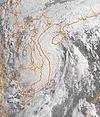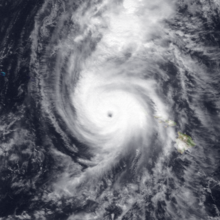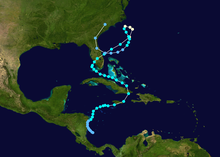Portal:Tropical cyclones
The Tropical Cyclones Portal

A tropical cyclone is a storm system characterized by a large low-pressure center, a closed low-level circulation and a spiral arrangement of numerous thunderstorms that produce strong winds and heavy rainfall. Tropical cyclones feed on the heat released when moist air rises, resulting in condensation of water vapor contained in the moist air. They are fueled by a different heat mechanism than other cyclonic windstorms such as Nor'easters, European windstorms and polar lows, leading to their classification as "warm core" storm systems. Most tropical cyclones originate in the doldrums, approximately ten degrees from the Equator.
The term "tropical" refers to both the geographic origin of these systems, which form almost exclusively in tropical regions of the globe, as well as to their formation in maritime tropical air masses. The term "cyclone" refers to such storms' cyclonic nature, with anticlockwise rotation in the Northern Hemisphere and clockwise rotation in the Southern Hemisphere. Depending on its location and intensity, a tropical cyclone may be referred to by names such as "hurricane", "typhoon", "tropical storm", "cyclonic storm", "tropical depression" or simply "cyclone".
Types of cyclone: 1. A "Typhoon" is a tropical cyclone located in the North-west Pacific Ocean which has the most cyclonic activity and storms occur year-round. 2. A "Hurricane" is also a tropical cyclone located at the North Atlantic Ocean or North-east Pacific Ocean which have an average storm activity and storms typically form between May 15 and November 30. 3. A "Cyclone" is a tropical cyclone that occurs in the South Pacific and Indian Oceans.
Selected named cyclone -
Hurricane Iniki (/iːˈniːkiː/ ee-NEE-kee; Hawaiian: ʻiniki meaning "strong and piercing wind") was a hurricane that struck the island of Kauaʻi on September 11, 1992. It was the most powerful hurricane to strike Hawaiʻi in recorded history, and the only hurricane to directly affect the state during the 1992 Pacific hurricane season. Forming on September 5, 1992, during the strong 1990–1995 El Niño, Iniki was one of eleven Central Pacific tropical cyclones during that season. It attained tropical storm status on September 8 and intensified into a hurricane the next day. After abruptly turning north, Iniki struck Kauaʻi at peak intensity; it had winds of 145 mph and reached Category 4 status on the Saffir–Simpson hurricane scale.
Winds gusted to 225 mph (362 km/h). It was the first hurricane to hit the state since Hurricane Iwa in the 1982 season, and the only known major hurricane to hit the state. Iniki dissipated on September 13, about halfway between Hawaii and Alaska. (Full article...)Selected article -
Hurricane Gordon developed during a fourteen-day period along an erratic, persistent, and highly unusual path. The hurricane formed near Panama in the southwestern Caribbean on November 8, 1994. As a tropical depression, it brushed Nicaragua and spent several days in the waters off the country's coast. Strengthening slightly into a tropical storm, Gordon wound its way north into the Greater Antilles. Despite warm waters, persistent wind shear prevented significant strengthening. Executing a slow turn to the north and then the northwest, Gordon made two more landfalls, on eastern Jamaica and eastern Cuba, while delivering tremendous rains to western Hispaniola.
As Gordon made its fourth landfall crossing the Florida Keys, it interacted with a cyclone in the upper-troposphere and a series of cyclonic lows which lent the storm some sub-tropical characteristics. After a few days as an unusual hybrid of a tropical and a subtropical system in the Gulf of Mexico, the storm re-claimed its fully tropical form and made yet another landfall, this time across the Florida peninsula, and continued into the Atlantic Ocean. In the Atlantic, Gordon rapidly strengthened to a Category 1 hurricane. Gordon's characteristic wandering briefly brought it near North Carolina, but ultimately the storm headed south, weakening into a minor tropical storm before making its sixth and final landfall on Florida's east coast. (Full article...)Selected image -
Selected season -

The 2016 Atlantic hurricane season was the first above-average hurricane season since 2012, producing 15 named storms, 7 hurricanes and 4 major hurricanes. The season officially started on June 1 and ended on November 30, though the first storm, Hurricane Alex which formed in the Northeastern Atlantic, developed on January 12, being the first hurricane to develop in January since 1938. The final storm, Otto, crossed into the Eastern Pacific on November 25, a few days before the official end. Following Alex, Tropical Storm Bonnie brought flooding to South Carolina and portions of North Carolina. Tropical Storm Colin in early June brought minor flooding and wind damage to parts of the Southeastern United States, especially Florida. Hurricane Earl left 94 fatalities in the Dominican Republic and Mexico, 81 of which occurred in the latter. In early September, Hurricane Hermine, the first hurricane to make landfall in Florida since Hurricane Wilma in 2005, brought extensive coastal flooding damage especially to the Forgotten and Nature coasts of Florida. Hermine was responsible for five fatalities and about $550 million (2016 USD) in damage.
The strongest, costliest, and deadliest storm of the season was Hurricane Matthew, the southernmost Category 5 Atlantic hurricane on record and the first to reach that intensity since Felix in 2007, ending the longest streak of seasons without a hurricane of such intensity in the Satellite Era. With at least 603 deaths attributed to it, Matthew was the deadliest Atlantic hurricane since Stan of 2005. Furthermore, damage from Matthew is estimated to be at least $16.5 billion, making it the ninth costliest Atlantic hurricane on record at the time. Hurricane Nicole became the first major hurricane to directly impact Bermuda since Hurricane Fabian in 2003, leaving widespread but relatively moderate damage on the island. The final tropical cyclone of the season – Hurricane Otto – brought severe flooding to Central America in November, particularly in Costa Rica and Nicaragua. Otto left 23 deaths and about $190 million in damage. On November 25, the storm emerged into the Eastern Pacific basin, the first such occurrence since Hurricane Cesar–Douglas in 1996. Most of the season's tropical cyclones impacted land, and nine of those storms caused loss of life. Collectively, the storms left at least 736 fatalities and $17.49 billion in damage, making the season the costliest since 2012. (Full article...)Related portals
Currently active tropical cyclones

Italicized basins are unofficial.
- North Atlantic (2024)
- No active systems
- East and Central Pacific (2024)
- No active systems
- North Indian Ocean (2024)
- No active systems
- Mediterranean (2023–24)
- No active systems
- South-West Indian Ocean (2023–24)
- No active systems
- Australian region (2023–24)
- No active systems
- South Pacific (2023–24)
- No active systems
- South Atlantic (2023–24)
- No active systems
Last updated: 00:02, 23 May 2024 (UTC)
Tropical cyclone anniversaries

May 23
- 1976 - Subtropical Storm One struck the Florida Panhandle, bringing heavy rainfall to the southeastern United States but only minimal damage.
- 2003 - Typhoon Chan-hom (pictured) reaches its maximum intensity as a Category 4 typhoon with a pressure of 940 mbar (27.76 inHg).

- May 24, 1989 - Tropical Storm Cecil (pictured) made landfall in central Vietnam where it killed 52 people and left over 100,000 others homeless.

May 25
- 1985 - A cyclone (pictured) made landfall in Bangladesh and killed 11,069 people.
- 2009 - Cyclone Aila moved ashore Bangladesh, causing 339 fatalities.
- 2018 - Cyclone Mekunu struck southern Oman, causing floods across the Arabian Peninsula, as well as 31 deaths.
Did you know…




- …that the Joint Typhoon Warning Center considers that Typhoon Vera (pictured) of 1986 is actually two distinct systems, formed from two separated low-level circulations?
- …that Hurricane Agatha (pictured) was the strongest Pacific hurricane to make landfall in Mexico in May since records began in 1949?
- …that Cyclone Raquel (track pictured) travelled between the Australian and South Pacific basins between the 2014–15 and 2015–16 seasons, spanning both seasons in both basins?
- …that Cyclone Amphan (pictured) in 2020 was the first storm to be classified as a Super Cyclonic Storm in the Bay of Bengal since 1999?
General images -

Topics
Subcategories
Related WikiProjects
WikiProject Tropical cyclones is the central point of coordination for Wikipedia's coverage of tropical cyclones. Feel free to help!
WikiProject Weather is the main center point of coordination for Wikipedia's coverage of meteorology in general, and the parent project of WikiProject Tropical cyclones. Three other branches of WikiProject Weather in particular share significant overlaps with WikiProject Tropical cyclones:
- The Non-tropical storms task force coordinates most of Wikipedia's coverage on extratropical cyclones, which tropical cyclones often transition into near the end of their lifespan.
- The Floods task force takes on the scope of flooding events all over the world, with rainfall from tropical cyclones a significant factor in many of them.
- WikiProject Severe weather documents the effects of extreme weather such as tornadoes, which landfalling tropical cyclones can produce.
Things you can do
 |
Here are some tasks awaiting attention:
|
Wikimedia
The following Wikimedia Foundation sister projects provide more on this subject:
-
Commons
Free media repository -
Wikibooks
Free textbooks and manuals -
Wikidata
Free knowledge base -
Wikinews
Free-content news -
Wikiquote
Collection of quotations -
Wikisource
Free-content library -
Wikiversity
Free learning tools -
Wikivoyage
Free travel guide -
Wiktionary
Dictionary and thesaurus

























































